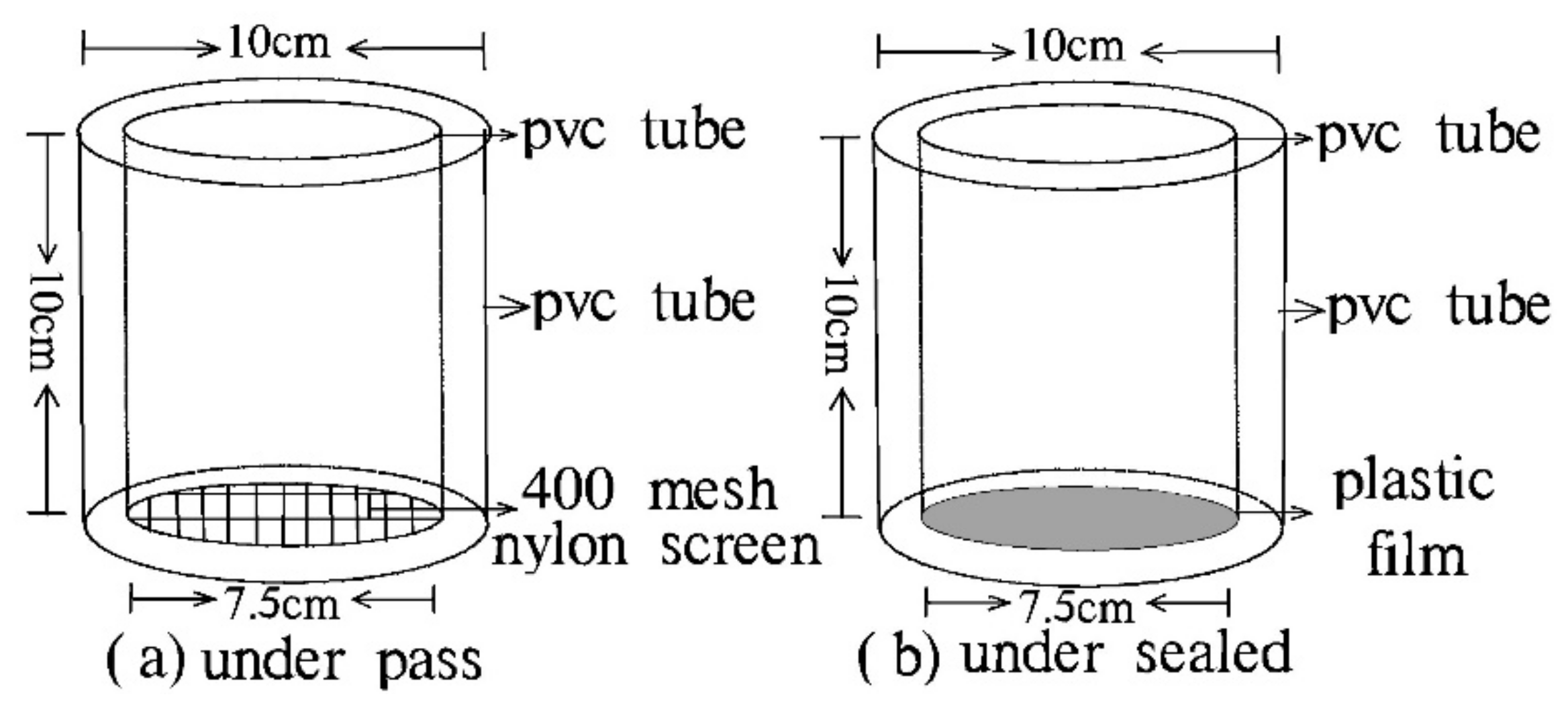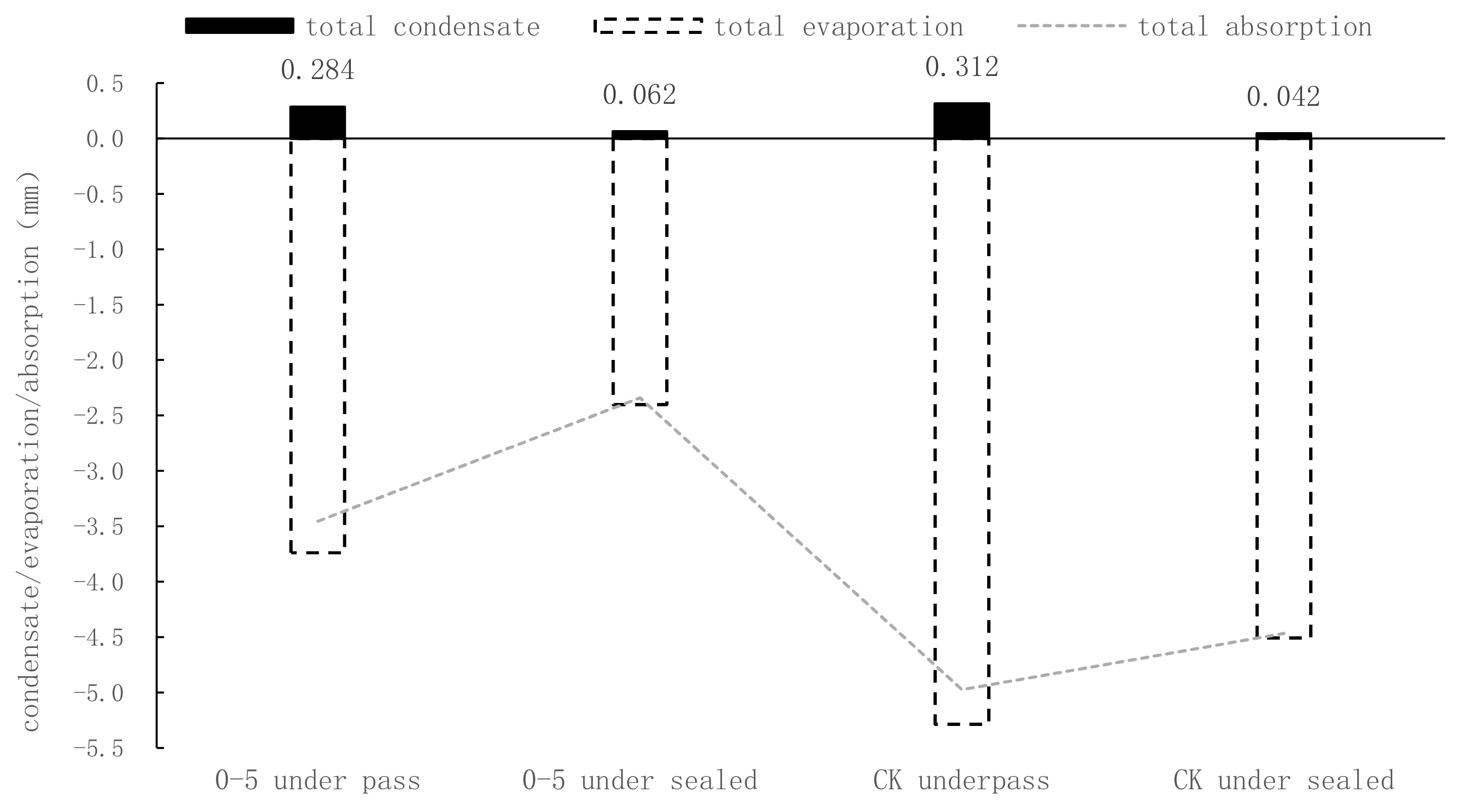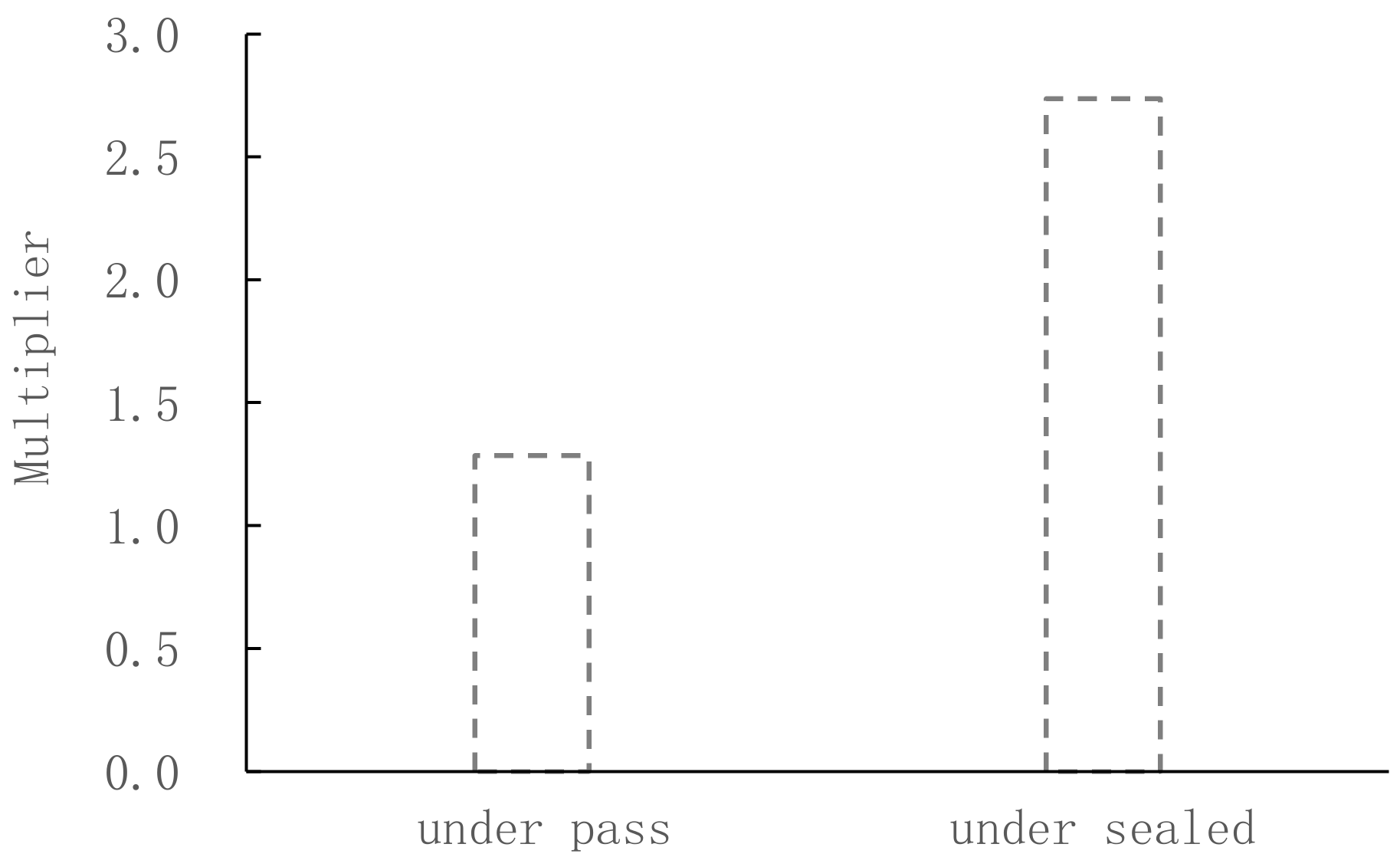Study of Condensate Absorption Capacity in Exposed Soil when Water Recedes at the Bottom of Hoh Xil Lake, Qinghai
Abstract
:1. Introduction
2. Overview of the Research Area and Research Background
3. Materials and Methods
3.1. The Experimental Materials
3.2. Experimental Methods
3.3. Calculating the Volume of Condensate
4. The Influence of the Condensate Generation Pattern
4.1. Influence of Sources of Condensation Generation
4.2. The Influence of Condensation Generation Time
4.3. The Influence of the Condensate Generation Volume
5. Ground Temperature Transport Patterns
6. Condensation Absorption Effect
7. Conclusions
- (1)
- Condensate exists in the Hoh Xil Salt Lake area, and there are two sources of soil condensation: condensation from atmospheric water vapor and condensation from deep soil pores. The amount of water vapor condensation in the lower part of the soil in the artificial water-retention layer conditions was 2.588 times the amount of condensation in the air near the ground, while the amount of water vapor condensation in the lower part of the bare ground was 1.783 times the amount of condensation in the air near the ground.
- (2)
- The artificial water-retention layer in the salt-lake area of Hoh Xil had little influence on the time of condensation generation, as it ended only slightly earlier than the bare ground, and the trend of the condensation rate remained the same. However, the unidirectional condensation of water vapor in the near-surface air in the artificial water-retention layer was significantly better than that of the bare ground, and the frequency of condensation was three times higher than that of the bare ground.
- (3)
- The total amount of bi-directional condensation in the artificial water-retention layer was slightly less than that of the bare ground, while the total amount of unidirectional condensation in the artificial water-retention layer was significantly higher than that of the bare ground. Together, this data indicates that the artificial water-retention layer helped to promote the absorption capacity of water vapor in the near-surface air.
- (4)
- Due to the existence of permafrost in the Qinghai-Tibet Plateau region, the zero-flux surface transport of heat dissipation in the salt-lake area of Hoh Xil lies approximately within 30 cm to the surface.
- (5)
- The analogous coefficient of wetness, which characterizes the coefficient of condensate absorption as the storage capacity of condensate in the surface layer of soil in a certain area. It strongly demonstrated that the condensate absorption capacity of the artificial water-retention layer in the Hoh Xil Salt Lake area was higher than that of bare ground, regardless of whether it was bi-directional or unidirectional condensation, with the absorption multipliers being 1.29 and 2.74 times, respectively.
Author Contributions
Funding
Institutional Review Board Statement
Informed Consent Statement
Data Availability Statement
Acknowledgments
Conflicts of Interest
References
- Zhang, Y.; Xie, C.; Zhao, L.; Wu, T.; Pang, Q.; Liu, G.; Wang, W.; Liu, W. The formation of permafrost in the bottom of the Zonag Lake in Hoh Xil on Qinghai-Tibet Plateau after an outburst: Monitoring and simulation. J. Glaciol. Geocryol. 2017, 39, 949r–956r. [Google Scholar]
- Li, S.J. The scientific expedition on the modern lake evolution in the Qinghai-Tibet Plateau: A preliminary report. J. Lake Sci. 1998, 10, 95–96. [Google Scholar]
- Liu, B.; Lin, L.I.; Yue, D.U.; Liang, T.; Duan, S.; Hou, F.; Ren, J. Causes of the outburst of Zonag Lake in Hoh Xil, Tibetan Plateau, and its impact on surrounding environment. J. Glaciol. Geocryol. 2016, 38, 305–311. [Google Scholar]
- Wang, Y.B.; Liu, X.Q.; Yang, X.D.; Zhang, E.L.; Matsumoto, R. A 4000-year moisture evolution recorded by sediments of Lake Kusai in the Hoh Xil area, northern Tibetan Plateau. J. Lake Sci. 2008, 20, 605–612. [Google Scholar]
- Yao, X.; Liu, S.; Sun, M.; Guo, W.; Zhang, X. Changes of Kusai Lake in Hoh Xil region and causes of its water overflowing. Acta Geogr. Sin. 2012, 67, 689–698. [Google Scholar]
- Yao, X.; Sun, M.; Gong, P.; Liu, B.; Li, X.; An, L.; Ma, C. Overflow probability of the salt lake in Hoh Xil region. J. Geogr. Sci. 2018, 28, 647–655. [Google Scholar] [CrossRef] [Green Version]
- Liu, W.H.; Xie, C.W.; Wang, W. Analysis on expansion trend and outburst risk of the Yanhu Lake in Hoh Xil region, Qinghai-Tibet Plateau. J. Glaciol. Geocryol. 2019, 41, 1–12. [Google Scholar]
- Xie, C.W.; Liu, W.H.; Wu, J.C.; Yang, G.; Zhang, Y.; Wang, W.; Liu, G. Environmental changes caused by the outburst of Zonag Lake and the possible outburst model of Yanhu Lake in the Hoh Xil region. J. Glaciol. Geocryol. 2019, 41, 1–16. [Google Scholar]
- Guo, B.; Chen, Y.N.; Hao, X.M.; Li, B.F.; Cao, Z.C. Characteristics of soil condensation water and its influencing factors on different underlying surfaces in the lower reaches of the Tarim River. J. Nat. Resour. 2011, 26, 1963–1974. [Google Scholar]
- Zhao, L.; Li, S.; Zhao, Z.; Yu, X.; Sun, L.; Zhao, P. Temporal and spatial evolution and regional difference analysis of urban ecological efficiency in arid and semiarid areas. Arid. Land Geogr. 2020, 43, 449–457. [Google Scholar]
- Guo, H.; Qian, Y.; Yuan, G.X.; Wang, C.X. Research progress on the soil vapor extraction. J. Groundw. Sci. Eng. 2020, 8, 57–66. [Google Scholar]
- Chen, R. Source of Soil Condensation Water in the Gurbantunggut Desert. J. Desert Res. 2012, 32, 985–989. [Google Scholar]
- Sun, Z.; Yu, S.; Zhou, A.; Zhang, J.; Yang, L. Experimental Study on the Condensation Water in Lop Nur Region, Xinjiang. Geol. Sci. Technol. Inf. 2008, 27, 91–95. [Google Scholar]
- Sun, X.X.; Zheng, D.J. Evaluation of Water Retention and Repeated Water Absorption Performance of 10 Different Super Absorbent Polymers (SAPs). For. Technol. 2022, 47, 35–39. [Google Scholar]
- Liu, Y.; Geng, D.D.; Han, Y.S. Environment-friendly Superabsorbent: Development, Property and Application. Chin. Agric. Sci. Bull. 2022, 38, 86–90. [Google Scholar]
- Li, B. Study on preparation of acrylic acid-bentonite water retaining agent and its water retaining effect. Jiangsu Agric. Sci. 2018, 46, 289–292. [Google Scholar]
- Dongsheng, H. Investigation and study on lake resources in Kekexili region. Arid. Land Geogr. 1992, 15, 50–58. [Google Scholar]
- Luo, C.G.; Han, F.Q.; Pang, X.P.; Zhou, J. Study on sublacustrine morphology of main lakes in Hoh Xil region. J. Salt Lake Res. 2010, 18, 1–8. [Google Scholar]
- Amiraslani, F.; Dragovich, D. Combating desertification in Iran over the last 50 years: An overview of changing approaches. J. Environ. Manag. 2011, 92, 1–13. [Google Scholar] [CrossRef]
- Zhang, J.; Zhang, Y.; Downing, A.; Cheng, J.; Zhou, X.; Zhang, B. The influence of biological soil crusts on dew deposition in Gurbantunggut Desert, Northwestern China. J. Hydrol. 2009, 379, 220–228. [Google Scholar] [CrossRef]
- Pan, Y.; Wang, X.; Zhang, Y. Dew formation characteristics in a revegetation-stabilized desert ecosystem in Shapotou area, Northern China. J. Hydrol. 2010, 387, 265–272. [Google Scholar] [CrossRef]
- Temina, M.; Kidron, G.J. Lichens as biomarkers for dew amount and duration in the Negev Desert. Flora-Morphol. Distrib. Funct. Ecol. Plants 2011, 206, 646–652. [Google Scholar] [CrossRef]
- Groh, J.; Slawitsch, V.; Herndl, M.; Graf, A.; Vereecken, H.; Pütz, T. Determining dew and hoar frost formation for a low mountain range and alpine grassland site by weighable lysimeter. J. Hydrol. 2018, 563, 372–381. [Google Scholar] [CrossRef]
- Kool, D.; Agra, E.; Drabkin, A.; Duncan, A.; Fendinat, P.; Leduc, S.; Lupovitch, G.; Nambwandja, A.; Ndilenga, N.; Thị, T.N.; et al. The overlooked non-rainfall water input sibling of fog and dew: Daily water vapor adsorption on a! Nara hummock in the Namib Sand Sea. J. Hydrol. 2021, 598, 126420. [Google Scholar] [CrossRef]
- Tomaszkiewicz, M.; Abou Najm, M.; Zurayk, R.; El-Fadel, M. Dew as an adaptation measure to meet water demand in agriculture and reforestation. Agric. For. Meteorol. 2017, 232, 411–421. [Google Scholar] [CrossRef]
- Yin, R.; Wu, Y.; Zhang, X.; Ha, S.; Tian, X.; Li, Z.; Wang, J.; Miao, H.; Ren, J. Effects of biological crusts on dew deposition and evaporation in the southern edge of the mu us sandy land, northern china. Acta Ecol. Sin. 2013, 33, 6173–6180. [Google Scholar]
- Jinlong, Z.; Aboduola, A.; Xianguang, D. An experimental study on the condensation water in the plain area of the northern slope of T ianshan Mountains. J. Xinjiang Agric. Univ. 2002, 25, 49–53. [Google Scholar]
- Jia, R.; Li, X.; Liu, L.; Pan, Y.; Gao, Y.; Wei, Y. Effects of sand burial on dew deposition on moss soil crust in a revegetated area of the Tennger Desert, Northern China. J. Hydrol. 2014, 519, 2341–2349. [Google Scholar] [CrossRef]
- Guo, Z.; Jing, E.; Nie, Z.; Jiao, P.; Dong, H. Analysis on the characteristics of soil moisture transfer during freezing and thawing period. Adv. Water Sci. 2002, 13, 298–302. [Google Scholar]
- Kidron, G.J.; Starinsky, A. Chemical composition of dew and rain in an extreme desert (Negev): Cobbles serve as sink for nutrients. J. Hydrol. 2012, 420, 284–291. [Google Scholar] [CrossRef]
- Woodhouse, J.; Johnson, M.S. Effect of superabsorbent polymers on survival and growth of crop seedlings. Agric. Water Manag. 1991, 20, 63–70. [Google Scholar] [CrossRef]
- Behera, S.; Mahanwar, P.A. Superabsorbent polymers in agriculture and other applications: A review. Polym.-Plast. Technol. Mater. 2020, 59, 341–356. [Google Scholar] [CrossRef]
- Nnadi, F.; Brave, C. Environmentally friendly superabsorbent polymers for water conservation in agricultural lands. J. Soil Sci. Environ. Manag. 2011, 2, 206–211. [Google Scholar]
- Luchen, L.; Ziyang, G.; Shugao, Q.; Yuqing, Z.; Liang, L.; Kaijie, Y. Foliar condensate absorption capacity of four typical plant species and their physiological responses to water in the Mu Us Sandy Land of northwestern China. J. Beijing For. Univ. 2021, 43, 72–80. [Google Scholar]
- Wei, C.; Yu, S.; Jichun, W.U.; Jing, L.I.; Shengting, W. Spatial variability of permafrost soil-moisture on the slope of the Qinghai-Tibet Plateau. Adv. Water Sci. 2017, 28, 32–40. [Google Scholar]
- Wang, W.H.; Wu, T.H.; Li, R.; Xie, C.W.; Zhu, X.F. An overview of advances on moisture migration of the active layer in permafrost regions of the Qinghai-Tibetan Plateau. J. Northwest Norm. Univ. 2017, 53, 102–111. [Google Scholar]
- Hu, G.; Zhao, L.; Li, R.; Wu, T.; Pang, Q.; Wu, X.; Qiao, Y.; Shi, J. Characteristics of hydro-thermal transfer during freezing and thawing period in permafrost regions. Soils 2014, 46, 355–360. [Google Scholar]







| Underpass | Under Sealed | |||
|---|---|---|---|---|
| 0–5 cm | CK | 0–5 cm | CK | |
| Experimental group | C1 | M | C4 | N |
| Parallel group | F1 | P | F4 | Q |
| Artificial Water-Retention Layer—Underpass | Artificial Water-Retention Layer—Under Sealed | Bare Ground— Underpass | Bare Ground—Under Sealed | |
|---|---|---|---|---|
| Multiplier | 13.17 | 38.91 | 16.93 | 106.50 |
Publisher’s Note: MDPI stays neutral with regard to jurisdictional claims in published maps and institutional affiliations. |
© 2022 by the authors. Licensee MDPI, Basel, Switzerland. This article is an open access article distributed under the terms and conditions of the Creative Commons Attribution (CC BY) license (https://creativecommons.org/licenses/by/4.0/).
Share and Cite
Li, B.; Zhu, L.; Chen, X.; Liu, J.; Zhang, Y.; Shi, W. Study of Condensate Absorption Capacity in Exposed Soil when Water Recedes at the Bottom of Hoh Xil Lake, Qinghai. Water 2022, 14, 1433. https://doi.org/10.3390/w14091433
Li B, Zhu L, Chen X, Liu J, Zhang Y, Shi W. Study of Condensate Absorption Capacity in Exposed Soil when Water Recedes at the Bottom of Hoh Xil Lake, Qinghai. Water. 2022; 14(9):1433. https://doi.org/10.3390/w14091433
Chicago/Turabian StyleLi, Bei, Liang Zhu, Xi Chen, Jingtao Liu, Yuxi Zhang, and Wanpeng Shi. 2022. "Study of Condensate Absorption Capacity in Exposed Soil when Water Recedes at the Bottom of Hoh Xil Lake, Qinghai" Water 14, no. 9: 1433. https://doi.org/10.3390/w14091433
APA StyleLi, B., Zhu, L., Chen, X., Liu, J., Zhang, Y., & Shi, W. (2022). Study of Condensate Absorption Capacity in Exposed Soil when Water Recedes at the Bottom of Hoh Xil Lake, Qinghai. Water, 14(9), 1433. https://doi.org/10.3390/w14091433





